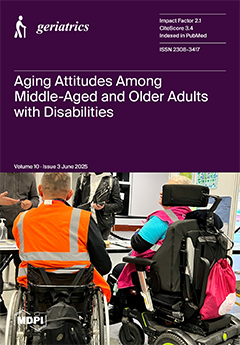Objectives: This study aimed to investigate the relationship between osteoporosis and cerebral small vessel disease (CSVD) burden in stroke-free individuals, as well as its specific imaging markers, including lacunes, enlarged perivascular spaces (EPVSs), white matter hyperintensities (WMHs), and brain atrophy (BA).
Methods: A total of 684 stroke-free patients who underwent both bone mineral density (BMD) assessments and brain MRI were included. Clinical data, CSVD burden scores, imaging markers of CSVD, and bone density parameters were collected. Logistic regression models were used to evaluate the relationship between BMD and CSVD burden and imaging markers.
Results: Osteoporosis, including hip and vertebral osteoporosis, was independently associated with CSVD burden (OR = 2.332, 95%CI: [1.345, 4.039],
p = 0.003; OR = 2.598, 95%CI: [1.540, 4.384],
p < 0.001; OR = 1.515, 95%CI: [1.010, 2.272],
p = 0.044). Increased BMD in the hip and spine correlated with reduced CSVD burden (OR = 0.929, 95%CI: [0.887, 0.972],
p = 0.001; OR = 0.952, 95%CI: [0.917, 0.989],
p = 0.012). Hip osteoporosis was a risk factor for lacunes (OR = 2.215, 95%CI: [1.197, 4.1],
p = 0.011), multiple lacunes (OR = 2.274, 95%CI: [1.039, 4.980],
p = 0.04), severe WMH (OR = 2.611, 95%CI: [1.171, 5.823],
p = 0.019), and EPVS ≥ 2 (OR = 1.99, 95%CI: [1.133, 3.495],
p = 0.017). No significant association was found between osteoporosis and BA (
p = 0.928). In sex-stratified analyses, both hip and vertebral osteoporosis were independently associated with a higher CSVD burden in female patients (hip: OR = 2.529, 95%CI: [1.122, 5.703],
p = 0.025; vertebral: OR = 3.129, 95%CI: [1.517, 6.455],
p = 0.002; general osteoporosis: OR = 1.755, 95%CI: [1.057, 2.912],
p = 0.03), whereas no significant association was observed in male patients (all
p > 0.05).
Conclusions: Osteoporosis was independently associated with an increased burden of CSVD, particularly evident in female patients. These findings suggest that bone health may be important in CSVD management, particularly for women.
Full article






